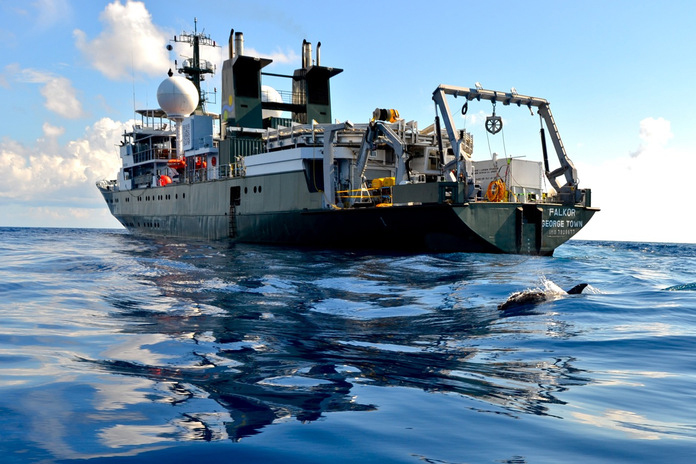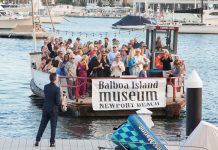
Although registered in the Cayman Islands, the 272-foot long private research vessel Falkor is a ship without a country. The world, however, is her “home” port.
Wherever there is marine research to be done, discoveries made, oceanic mysteries solved or scientific history to be written, the Schmidt Ocean Institute’s dedicated research/laboratory ship, Falkor, will find her way there.
Falkor and the work she has done (and is doing) since her re-fitting and christening in 2010, with teams of visiting scientists from around the world, were showcased as the latest of seven nautically-themed lectures presented at ExplorOcean at the Balboa Fun Zone on Thursday, March 5.
The audience of school kids and interested adults certainly was impressed by the scope of the ship’s surface-to-bottom explorations as described by Carlie Wiener, the Institute’s Communications Manager – herself a veteran of several extended voyages aboard the Falkor.
The Schmidt Ocean Institute’s overall purpose is easily fathomed: “The world’s ocean understood through technological advancement, intelligent observation and open sharing of information.”
Currently, Falkor’s onboard scientists are studying largely unexplored Perth Canyon, considered one of Australia’s subsea treasures.
Speaking via marine radio directly to ExplorOcean’s audience, scientists on board described eight-hour long submarine explorations via RPVs into the 4,500-meter-deep canyon as they seek unique animal life, study deep-sea corals, measure river-like deep-down tidal waves the height of sky scrapers, and contemplate the impacts of a warming sea and ocean acidification.
Getting a research spot aboard Falkor is no easy task: it can take up to two years of preparation by elite scientific teams from around the world before even being considered by a judging panel for a berth aboard.
No matter where the research is to be conducted, Falkor will steam to those coordinates.
Falkor’s financial resources are as seemingly deep as some of the ocean trenches that Falkor examines. The Schmidt Ocean Institute was founded by and funded solely by billionaire philanthropists Eric Schmidt, former executive chairman of Google, and his wife, Wendy. To that end, Schmidt Ocean Institute is well positioned for years of valuable research to benefit the world.
Two lectures remain in ExplorOcean’s 2014-15 informative series.
On April 16, John W. Foster, State of California Archaeologist (ret.) will talk about “Archaeology Underwater: Exploration and Conservation Beyond the Shores of Time.
A native of Burbank, Foster got his start in archaeology as a boy while visiting an uncle’s farm in Sumter, SC, when he and a school chum dug up, collected and filled several cans with arrowheads. That boyhood spark developed at UC Santa Barbara, then later at UCLA, where he earned his BA in Anthropology, then later at MA degree from Long Beach State University. After more graduate work at University of Arizona, he returned to California to begin his career in Sacramento, with the State Parks, starting in the Cultural Heritage Section. This allowed him to discover, record, investigate and preserve historic sites through the state. He is California’s only “underwater archaeologist,” and has been responsible for discovering and exploring a variety of shipwrecks, including the SS Pomona site at Fort Ross, and later the Montebello, a freighter torpedoed off the coast of Cambria.
On May 14, Dr. John Bailey from Google Earth will talk about “Education and Ocean Initiatives.”
Dr. Bailey, an assistant professor at the University of Alaska, Fairbanks, hails from England, but is a US-trained volcanologist and neogeographer. He divides his time teaching for the Geography department at the university, and working as a geovisualization specialist for a climate change research group.
Bailey developed the first U.S. university-accredited, full-semester class to teach how Google Earth, Keyhole Markup Language and related applications can be used to augment education and research. He is well known and respected for having organized some of the most popular sessions and workshops at the American Geophysical Union of America and Geological Society of America meetings – two of the world’s largest annual confabs of Earth Science educators and researchers.
Bailey’s goal is to promote understanding of the Earth and the processes shaping its surface through the use of innovative technologies.
For more information about ExplorOcean and its many programs, visit ExplorOcean.org.
Contact the writer: Pleasepitchrich@yahoo.com.




